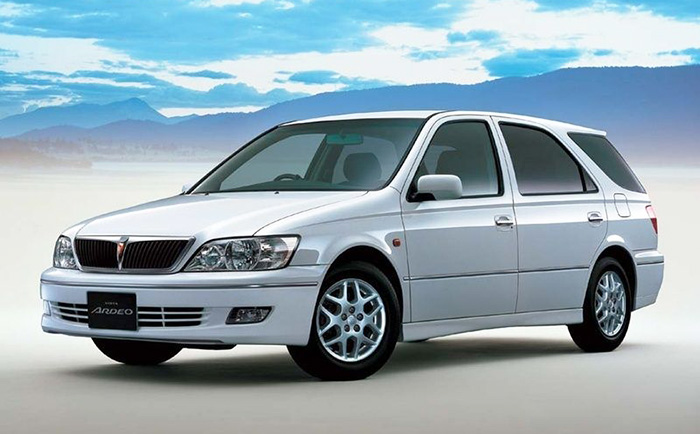

Toyota Vista
The Toyota Vista is a compact car launched in 1982 as a sister nameplate to the Camry by Toyota in Japan. The name was introduced to tie in with the Toyota Vista Store dealership network, and launched around the same time. Unlike the Camry, which from 1988 was available with a V6 engine, all generations were only available with a straight-four engine that used either gasoline or diesel fuel.
Each Vista model is essentially a Japanese-market Toyota Camry, with different front- and rear-end treatment; plus, while the Camry has always been a sedan, with exception to the first generation available also as a hatchback, most Vistas up to the V40 series are hardtops. The Camry is also exclusive to Toyota's Japanese dealership sales channel Toyota Corolla Store, as the first Camry was a development from the Toyota Celica, also only available at the Corolla dealership. When the Camry was redesigned, so was the Vista. This pattern continued until late 1996, when a new, larger, "global" Camry took over the "Camry" name. Prior to 1996, this larger CX/CV platform was marketed in Japan as the Scepter (MCV10) and Camry Gracia (MCV20/MCX20). Then in August 1998 the last generation Vista would be redesigned, independent of the Camry. The Vista is a popular used import in Ireland, as it is generally a favourite with taxi drivers.
The Vista was replaced by the Toyota Avensis in Japan when the Vista Store was renamed as Toyota Netz in 2004.
First generation V10 (1982–1986)
The Vista first appeared April 1982 as a nicer trim level of the second generation Toyota Camry, and was sold exclusively at a new Toyota dealership channel with the same name, Vista. The bodystyles offered were the 4-door sedan and 5-door hatchback with a 5-speed manual transmission initially the only offering, with an automatic transmission introduced later in August 1982. Trim levels were the VC, VL, VE, and the VX at the top. The official name of the vehicle was the Camry Vista. A glass moonroof was available on the top level VX, with the 2S-ELU engine.
August 1983 saw the 1C-TL 1.8 L turbodiesel offered, and the diesel-powered car was exclusive to Toyota Japan dealerships called Toyota Diesel Store locations. June 1984 saw the suspension given a more sporting approach, and a DOHC 2.0 L engine was offered on the VS trim level. A DOHC engine in a front wheel drive vehicle was unusual at the time. The diesel was upgraded to 2.0 L August 1985.
Second generation V20 (1986–1990)
The second generation Vista was first offered for sale August 1986, and unlike its higher spec cousin, the Lexus ES, the Vista was not available with a V6 engine. The 5-door hatchback was replaced with either a 4-door sedan or hardtop bodystyle, with a similar appearance to the larger Mark II. The Vista continued a Toyota tradition of becoming a sportier version of a more basic sedan, and came it a GT trim level. All engines now use fuel injection exclusively.
October 1987 saw the introduction of 4WD on the 2.0 L 4S-Fi engine, mated to an automatic transmission, and the Vista Etoile used the 4S-FE engine.
Third generation V30 (1990–1994)
This version of the Vista shares similar styling with the Windom. It was introduced July 1990. The engines available were the 4S 1.8 and 3S 2.0 L. The diesel engines used the 2C-T and all engines came with DOHC. Four wheel steering was also available on vehicles with the 2.0 L gasoline engine. The VX trim level was available in May 1991 with leather interior. July 1992 saw the removal of the 3S-GE engine on upper trim level vehicles.
Fourth generation: V40 (1994–1998)
While the Camry became a US-centric model with the narrower, shorter Japanese version eliminated, the Vista was now the only vehicle that continued to be built around the 4,700 mm (185.0 in) x 1,700 mm (66.9 in) length-width bracket, legacy of a Japanese taxation law. With this redesign, however, Toyota decided to revitalize the Vista nameplate. The car is 100 mm (3.9 in) taller than its predecessor.
This Vista is significant because it's one of the first fruits of Toyota's company-wide platform renewal efforts. Studies for new FWD platform and packaging (layout) began in 1993 and appeared on market in February 1997 in the Toyota Prius, but the Vista is the first mass-production, FWD Toyota with a new platform. Toyota claims this is the first true redesign and re-think of its FWD platforms since the 1982 Camry/Vista. With this platform, Toyota trades rear McPherson Struts for a torsion beam axle setup. A double-wishbone setup reminiscent of the Nissan Primera axle is available for all-wheel drive—this will become the rear suspension for more demanding FWD cars such as the final Toyota Celica. Toyota also flips the engine orientation so that the intake manifold is in front, improving space efficiency.
Fifth generation V50 (1998–2003)
Production for the Vista halted in July 2003, as Toyota prepared to rename the Vista dealers as the Netz dealership network. The move to simplify Toyota's dealership came in light of the pending Lexus launch in Japan, planned for August 2005. In April 2005 the process was complete and all Vista dealers became Netz dealers. The fifth generation Vista was available as a sedan, and a station wagon called the Vista Ardeo. 1.8 L and 2.0 L engines were available. The interior features a center instrument panel/navigation display.
The platform for this vehicle was shared with the Opa, Wish, and Avensis.







